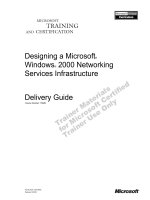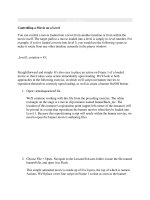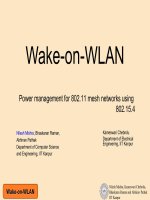Tài liệu Conducting a WLAN Site Survey ppt
Bạn đang xem bản rút gọn của tài liệu. Xem và tải ngay bản đầy đủ của tài liệu tại đây (729.18 KB, 6 trang )
Conducting a WLAN
Site Survey and
Implementation for
the Cisco Unified
Wireless Network
1-800-COURSES
www.globalknowledge.com
Expert Reference Series of White Papers
Written and provided by
GigaWave Technologies® White Paper
Conducting a WLAN Site Survey and Implementation for
the Cisco Unified Wireless Network
Author: Keven Dech, Director of Training Services, CCSI, CCDA
All content is the property of GigaWave Technologies, a division of TESSCO Technologies. ©2007 All rights reserved.
All content is the property of GigaWave Technologies, a division of TESSCO Technologies. ©2007 All rights reserved.
GigaWave Technologies® White Paper
Page 1
Introduction
When preparing to conduct a site survey for a Cisco wireless LAN (WLAN) installation, follow the Cisco network
design methodology. Cisco’s Prepar
e, Plan, Design, Implement, Operate and Optimize (PPDIOO) addresses
the network in a phased approach. This white paper provides a “how to” overview that can be used when
conducting a site survey and installation for a Cisco WLAN. In doing so, the Prepare, Plan, Design and
Implement phases should be followed.
Prepare
The prepare phase addresses specifics that should be addressed prior to any in-depth planning or design.
During the “prepare” phase, an organization should ask and answer a number of pertinent questions that will
impact the deployment of the WLAN. Preparatory work includes: Identifying what the organization can justify
financially, what the wireless network design should support, what services are to be supported on the wireless
network, data, voice, location based services? Additionally, what clients are to be supported, laptops, hand-
helds PDA’s, active RFID tags? You need to have the answer to all these questions, and more, prior to
entering the planning phase.
Plan
During the planning phase a project plan is developed to manage tasks, responsible parties, resources and
milestones. If there is a current network in place, planning should address any impact on the existing network
by adding controllers and access points. Is the existing available ports for access points and controllers to be
connected to existing switches or will additional switches be added to the network to support the controllers and
access points? Do current switches for access points support Power over Ethernet (PoE)? Will there be N+1,
N+N redundancy or N+N+1 redundancy?
If this is to be a new network, then the site survey and design phase will dictate what equipment is needed to
support the controller based WLAN. If you purchased the Wireless Control System (WCS) from Cisco, load
campus buildings and floor plans that will support WLANs into WCS. Use the planning tool feature in WCS to
determine the amount of access points and placement for the services you plan to support, such as data, voice,
or location based services.
The WCS can generate access point density and coverage based on the services supported as well as the
amount of users that will access the WLAN. Once the number of access points has been determined, the
number of controllers needed to support the access points will be dictated.
Once you have accomplished the steps outlined above, you are ready to perform a site survey which includes
the following:
Layer One Sweep With Cognio Spectrum Expert
Cognio’s Spectrum Expert can identify and locate any non-802.11 devices that may cause interference with the
proposed WLAN - be it in the 2.4 or 5 GHz spectrum or both. Sweep all areas where access points will be de-
ployed with Cognio Spectrum Expert to identify any devices that may interfere with the proposed WLAN. These
devices could be cordless phones, microwave ovens or any other device that use the license free Industrial
Scientific Medical Band (ISM band) or Unlicensed National Information Infrastructure bands (UNII 1-3), but are
not IEEE 802.11 devices. Once any of these devices are identified that can cause interference, they can be
All content is the property of GigaWave Technologies, a division of TESSCO Technologies. ©2007 All rights reserved.
GigaWave Technologies® White Paper
Page 1
removed or replaced by devices that do not operate in the 2.4 or 5 GHz frequency bands. Cognio Spectrum
Expert will also identify other 802.11 devices that may be heard from surrounding WLAN installations in the
area.
Performing a WLAN Site Survey
Next, use AirMagnet Survey PRO for the site survey. This survey program provides all the data needed to
ensure a proper site survey for data, voice or location based services.
The site survey is a process of identifying access point placement for coverage. This is done so additional
access points can be placed to achieve the appropriate signal to noise ratio (SNR) for WLAN services
supported. The site survey process ensures needed signal levels and overlap with minimal interference to
other access points.
Prior to performing a site survey identify what devices are being supported on the WLAN to determine
appropriate signal levels and these vary depending on the following:
Data: WLAN data-only networks are dependent only on SNR for data rate supported and proper cell overlap
(Normally 10 to 15 percent, 20 percent is recommended).
Voice: WLAN Voice networks are critical to SNR, data rate supported and proper overlap (20 percent). QOS
must also be configured on controllers at installation for voice. Data rates below 11 Mbps should be disabled.
If you are surveying for data and voice only, ensure your cell edges are at a minimum of -67 dBm with 20
percent overlap. Access points on the same channel should have at least a 19 dBm SNR ratio of separation
from each other. For more information on deploying WLAN voice, refer to Cisco 7920 Design and Deployment
Guide available at Cisco.com
Location based services: WLAN Location Based Services requires that access points are placed in such a
fashion that the Active RFID tags and 802.11 clients are surrounded by access points for ultimate optimization.
(This is a different access point placement strategy than data and voice WLAN only networks). If you are
surveying for location based services, access point placement is done differently. For more information on
deploying location based services, refer to the Cisco 2700 Series Wireless Location Appliance Deployment
Guide available at Cisco.com.
Power: Power should be reduced to half power which is dependent on the data rate you are surveying for. This
will enable Auto RF features on the controllers to function properly. Surveying at full power for the data rate
supported is not recommended.
Design
Once the survey is complete, the location and number of access points that will require cabling back to wiring
closets throughout the network will be determined. The access point count will dictate the minimum number of
controllers required to support the WLAN.
Network design, placement and configuration of WLAN controllers can vary greatly due to the size of the
network to be supported. The redundancy designed into the network and the services supported on the
network will also impact controllers. WLAN controllers can be placed in a data center or a central location or
distributed across the campus distribution layer.
GigaWave Technologies® White Paper
Page 1
When designing the network to support the Cisco WLAN controllers and access points, take the top-down
approach. This means to start at layer 7 of the OSI model and work your way down to layer 1. This will
incorporate all applications and services that will run across the wireless network. Additionally, keep the
following in mind:
• VoWLAN requires QOS configurations on the controllers that support the voice WLAN / VLAN.
• A WLAN security policy should be developed for implementation.
• Guest networks require that the controller supporting guest services be placed in the DMZ of your
network for security reasons.
• If roaming is to occur and there is more than one controller on the network, then Mobility Groups
must be setup on the controllers.
• For optimizing auto RF you should configure RF Groups.
For further reference to design and configuration for WLAN controllers, refer to the Cisco Enterprise Mobility 3.0
Design Guide available at Cisco.com.
Implement
Once you have completed your site survey and design, you are ready for installation.
Prior to access point installation, all access point cabling back to wiring closets must be in place with POE
switch ports available for each access point. Ethernet runs should not exceed a 100 meters and should be
scanned to ensure they meet appropriate signal levels and have been terminated properly.
The network should support DHCP option 43 or DNS so that access points can locate controllers on the
network to join.
TEST
Bring the wireless network up and test all areas for proper coverage, roaming and services supported.
Verify that the WCS can see all WLAN controllers and access points installed.
Use the AirMagnet Survey PRO tool to do a passive survey of each floor covered. This provides a visualization
of any weak signal areas that need adjustment. Make adjustments to correct if needed.
If voice services were installed, make test calls throughout the WLAN to insure that Cisco 7921 or Nokia
phones are working properly with Cisco Call Manager.
If location based services are to be supported, check how well WCS can locate devices using the location
appliances installed. A calibration on each floor with WCS may need to be performed in order to enhance
location based services.
These steps are covered in depth in the recently released Cisco Wireless Networking Site Survey course. This
four-day course is full of hands-on labs and gives students a firm understanding of how to conduct a thorough
site survey. The course was developed for technical engineers and IT professionals tasked with performing or
overseeing site surveys for wireless LAN implementations. Visit www.giga-wave.com for a detailed course
overview and training schedule.
All content is the property of GigaWave Technologies, a division of TESSCO Technologies. ©2007 All rights reserved.
All content is the property of GigaWave Technologies, a division of TESSCO Technologies. ©2007 All rights reserved.
GigaWave Technologies® White Paper
Page 8
About the Author
Keven Dech is a Wireless Training Specialist and Director of Training Services at GigaWave Technologies.
Since March of 2001 he has conducted training for Cisco Systems’ Aironet Wireless LAN product set.
He received his Cisco
Certified Systems Instructor (CCSI) status on February 26, 2001. During his time with
GigaWave
Technologies, Keven has trained Cisco Employees, Cisco distributors, Cisco premier partners, Cisco
resellers and Cisco end-users.
Keven Dec
h brings over 20 years experience in both wireless voice and data communications with a broad
knowledge
of both licensed and unlicensed wireless systems to the classroom. Keven Dech maintains a 4.70+
average instructor rating out of a maximum rating of 5.00 in the Cisco Certified Systems Instructor rating system.
Cisco Systems requires a minimum rating level of 4.25 in the Cisco Certified Systems Instructor rating system.
The ratings are based upon student evaluations. Keven has over 3 years of formal Radio Frequency and
Electrical systems repair training from the United States Army.
Suggested Cisco Unified Wireless Courses and Technical Training
Cisco Wireless Networking Site Survey
The Cisco Wireless Network Site Survey course (CWNSS) is now available from Cisco. This course covers
wireless su
rvey methodologies for data, voice and location based services. This four-day course includes hands-
on labs that cover the following:
• Understanding detailed modulation and spreading techniques
• Identifying components, topologies and proper channel use
• How to use Cisco WCS planning tool for proper AP count assumption
• How to use the Cognio Spectrum Expert for detection of RF interference
• How to use AirMagnet Site Survey PRO for detailed analysis of signal overlay and signal overlap
• Understanding and designing different network designs for data, voice and/or location based services
• Performing a floor calibration using Cisco Wireless Control System (WCS)
About GigaWave Technologies
GigaWave Technologies offers innovative wireless networking workshops for IT professionals who want to know
how to design, install, secure or sell high performance Wireless Local Area Network (WLAN) and bridging
technologi
es. As a leading provider of WLAN training, curriculum development and wireless services, GigaWave
provides its trademark, high-caliber, hands-on training techniques to progressive organizations across the globe.
GigaWave specializes in wireless networking and has attained an unrivaled level of WLAN expertise.
As an auth
orized Cisco Learning Partner, GigaWave Technologies develops and delivers the Cisco wireless
networking
classes. For the most current training schedule and to view full course descriptions, go to
www.giga-wave.com
, or call 210-375-0085. GigaWave is a division TESSCO Technologies.
10521 Gulfdale
San Antonio, Texas 78216
210-37
5-0085 Phone
210-37
5-8382 Fax
www.giga-wave.com









